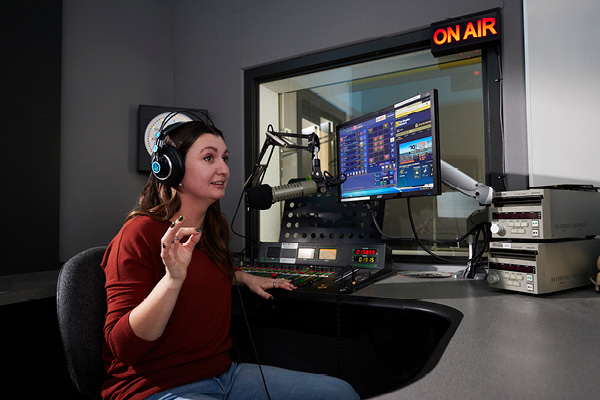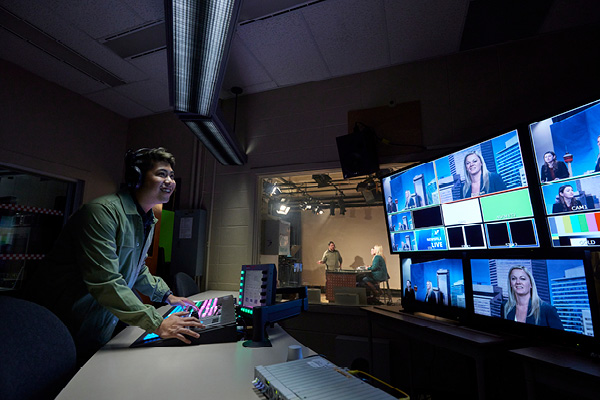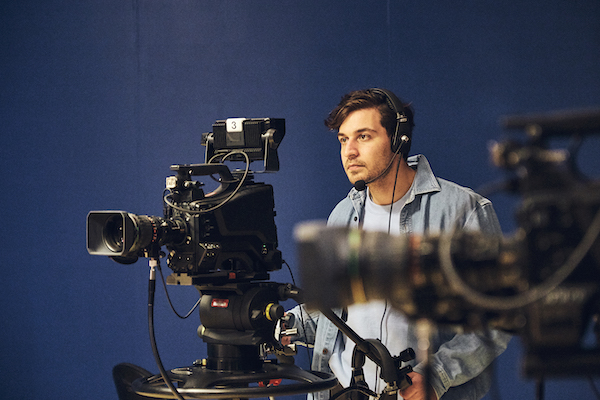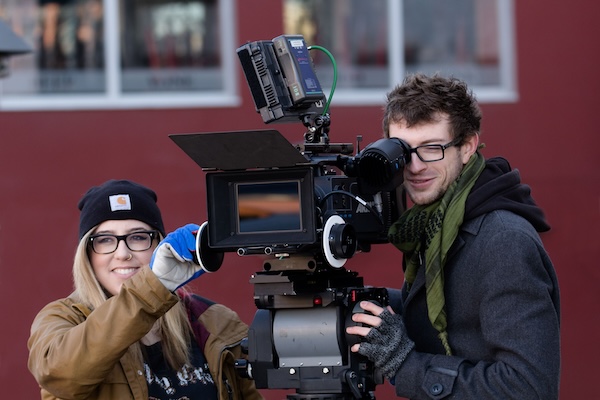On this page:
Overview
Are you ready to make waves in radio broadcasting, podcast production, voice acting and more? The Radio major within the Radio, Television, and Broadcast News program at SAIT is your ticket to an exciting career in audio entertainment and communication.
At SAIT, we understand the power of the spoken word and the art of audio storytelling. Our Radio major offers an exceptional learning experience that combines classroom instruction with hands-on training and real-world exposure.
You'll get hands-on experience by hitting the airwaves on SAIT's campus radio station, saitradio.com. Whether you dream of being a radio personality, newscaster, DJ or podcast host, you'll have the chance to hone your skills in a real broadcasting environment.
Build advanced audio production experience by learning the art and science of audio production with our facilities and equipment. Learn advanced multi-track digital audio production techniques, ensuring you have the technical skills to create high-quality content that stands out in today's competitive media landscape.
Craft compelling stories that capture your audience's attention. Our program provides extensive training in creative writing, helping you develop the ability to script engaging and entertaining radio segments, podcasts and other audio content.
Finally, develop an understanding of the importance of marketing and promotion in the media industry. Gain valuable insights into promotional planning and execution to effectively connect with your target audience and build a loyal following.
Take it from our graduates
Our radio broadcasting program has a record of producing successful graduates who make their mark in Calgary, Canada, and even on the international stage.
Many of our graduates are radio personalities and DJs, hosting their own shows and engaging audiences. Some work behind the scenes as producers or writers, contributing to and shaping stories. Others have discovered opportunities as voice actors for animation, videos or commercials.
Our alumni network includes individuals who have achieved remarkable success, such as the SAIT radio grad who became the imaging director and head sound designer for Howard Stern's stations on Sirius XM.
This program involves two years of full-time study, along with an industry practicum in your fourth semester.
Are you ready to be the next voice that captivates the airwaves? SAIT's Radio major within the Radio, Television, and Broadcast News program is your gateway to a rewarding and dynamic career.
Those in radio are innovative, directive, social and methodical.
You need:
- creativity
- self-confidence
- friendliness and a positive attitude
- good voice projection and enunciation
- excellent writing and reading skills
- an accurate memory
- the ability to "ad-lib" and provide interesting small talk
- a high level of enthusiasm
- adaptability and perseverance
- passion for your work
- the ability to work with a wide variety of people
- the ability to give and take constructive criticism.
You should enjoy working with music, videos and other news and entertainment, entertaining others and finding innovative solutions to problems.
You will participate in a four-week practicum at a participating radio station in positions related to writing/advertising, production or on-air.
Upon successfully completing this program, you'll receive a SAIT Radio, Television and Broadcast News diploma with a major in Radio.
Careers and opportunities
Each year, SAIT conducts a survey between February and April to determine the employment rate, salary and satisfaction of our newest SAIT alumni.
![]() 100% graduate employment rate
100% graduate employment rate
Find out more about our graduate employment statistics >
Our graduates may work in the following occupations. Some careers require additional experience and education.
Associated National Occupational Classification (NOC) codes: 50011, 51120, 52112, 52113, 52114, 52119, 53111.

Career planning support
Unsure which career path is for you? Here are some recommended career planning resources to help you decide your future.
You can also head to Alberta alis for lots of information about careers in Alberta, including quizzes and labour market information to help you narrow down a path.
Finally, you can take our online career finder quiz, which can help narrow your options based on your current skills and interests.
Courses
The Radio, Television and Broadcast News - Radio diploma requires 61.5 credits (26 courses) to complete.
The program spans two years, with two semesters each year.
You must take all of the following courses to complete this program.
General core
| Course | Credits |
|---|---|
|
This course is an introduction to computer fundamentals with emphasis on skills training. Theoretical components include Internet technology and terminology. Practical skills include file management, basic skills in word processing, spreadsheet applications, and presentation applications. Web applications and webpage design skills will be developed. |
1.5 |
|
The focus of this course is to develop and assess the writing skills essential for the broadcast industry. Topics include scriptwriting fundamentals, grammar, styles, script formats, research, and development of interview questions. |
3 |
|
This course provides emerging and existing leaders the opportunity to explore the concept of leadership and to develop and improve their leadership skills. The participant gains an understanding of leadership, articulates a personal philosophy of leadership, and applies various leadership skills. Involvement is accomplished through assigned readings, discussion, role playing, experiential activity, use of multimedia, journal writing, and extracurricular project and leader shadowing. |
1.5 |
|
Audio Video Production introduces learners to the basic tools and techniques of audio and video production. Learners develop production skills, forming the basis for advanced Radio, Television, and Broadcast News program elements. Through practical experience, learners explore digital audio production, audio/video editing, interview production, camera composition, single camera production techniques, and visual storytelling production and planning. Equivalents:
|
3 |
|
Creative expression and the concepts of dramatic, mental and physical involvement in performance are key elements to a future broadcasting career. Students study the foundational elements of improvisation, movement, dramatic interpretation, voice production, articulation, enunciation and public speaking. |
3 |
Radio core
| Course | Credits |
|---|---|
|
This course introduces the learner to the fundamentals of radio advertising. Learners work independently on writing projects in conjunction with course work from AUDI 252, Radio Production I. Instruction is provided through individual tutorial sessions. Pre-requisites:
Corequsites:
|
1.5 |
|
This course concentrates on client services and station profile enhancement. Learners participate as Account Executives (sales) and Creative Consultants (writers) servicing the client base of the SAIT Campus Radio station. In addition, learners create simple station promotions. Pre-requisites:
Corequsites:
|
3 |
|
This course concentrates on pinpointing precise client needs and creating advertising campaigns that best service the clients with an emphasis on the sales-creative team approach to revenue generation. Learners also execute the promotions planned in ADVR 304. Pre-requisites:
Corequsites:
|
1.5 |
|
This course is designed to introduce students to the radio industry. Through lecture, class discussion, research assignments, guest speakers, and so on, students will gain an understanding of the key elements of the business of radio. Specific topics include the organizational structure of the radio industry, on-air and programming elements, and radio advertising, marketing and promotion. |
3 |
|
This course provides learners with an understanding of radio station operations. Learners are instructed on and given assignments in program log creation, remote broadcasting, commercial production and on-air operations. Pre-requisites:
Corequsites:
|
6 |
|
This course provides audio equipment operations instruction designed specifically for Radio learners. Assignments are given on audio console operations, production techniques, audio patch bay theory and operations, field recording and newsroom equipment. Pre-requisites:
Corequsites:
|
3 |
|
This course provides advanced commercial, public service announcement, program and feature production instruction. Learners are also introduced to the theory and application of external production devices. Pre-requisites:
Corequsites:
|
3 |
|
Learners participate in all areas of station operation including using our computerized traffic system and computer-managed music library. Learners also design and produce a variety of programming material. Pre-requisites:
Corequsites:
|
3 |
|
This course provides advanced commercial, public service announcement, program and feature production instruction. Learners are also introduced to the theory and application of external production devices. Pre-requisites:
Corequsites:
|
1.5 |
|
Learners participate in all areas of station operation including using our computerized traffic system and computer-managed music library. Learners also design and produce a variety of programming material. Pre-requisites:
Corequsites:
|
3 |
|
This course introduces the learner to the fundamentals of Social Media as it is used in the electronic media. Learners work on and through a variety of social media projects that include, but are not limited to, Facebook, Twitter, YouTube, and Web 2.0, with a focus on their proper use in broadcast settings. Instruction is provided through individual and group projects, lectures, tutorials, and hands-on application. Equivalents:
|
1.5 |
|
This course provides learners with the skills required for understanding the basic structure and content of radio news and sportscasts. Preparing, rewriting copy and deciding the lineup of a newscast is the main focus of this course. Emphasis is placed on the need for a clear, concise and literate writing style. Pre-requisites:
|
1.5 |
|
Learners prepare and deliver news and sportscasts for radio. These casts are broadcast on the campus radio station. Learners write and execute story ideas and produce a news feature. Pre-requisites:
Corequsites:
|
1.5 |
|
JOUR 362 provides further experience in preparing and delivering news, sports and farmcasts for radio. These casts are broadcast on the campus radio station. Pre-requisites:
Corequsites:
|
1.5 |
|
PRAC 397 is a four-week, experiential opportunity conducted on-site at a participating radio station. It is designed to provide learners with a sense of what working in the industry is really like. Practicums are completed in one of, or a combination of, writing/advertising, production, or on-air positions. Pre-requisites:
|
1.5 |
|
The course covers the preparation and presentation of a dramatized stage script and expands learner appreciation of dramatic text. Learners are involved in onstage and backstage positions. Pre-requisites:
|
3 |
|
This course is designed to aid the learner in developing an individual voicing style suitable for on-air and commercial work. Focus will be placed on dramatic technique, on-air delivery, ad-libbing skills, and commercial voicing. Pre-requisites:
Corequsites:
|
3 |
|
This course is designed to help the learner achieve a level of presentation suitable for an introductory level job in industry. Focus will be placed on on-air announcing, commercial reading, dramatic reading, and feature reading. Pre-requisites:
Corequsites:
|
3 |
|
This course focuses on scriptwriting fundamentals for foreground features. The scripts written will be used in radio. Pre-requisites:
|
1.5 |
|
This course is structured around seminars and individual consultations in advanced scriptwriting. Learners will research and write scripts that meet creative and technical standards required for radio production. Pre-requisites:
Corequsites:
|
1.5 |
|
This course comprises individual consultation in advanced scriptwriting. Scripts developed by learners meet creative and technical standards required for radio production. Pre-requisites:
Corequsites:
|
1.5 |
Progression
You must attain a PGPA and/or a CGPA of 2.0 or better each semester and pass the prerequisite courses to progress through the program.
To qualify for graduation, you must pass all courses, attain a CGPA of 2.0 or better and complete course requirements within the prescribed timelines.
Review our grading and progression procedure >

Explore your options!
Some courses in this program are available through Open Studies. You can complete courses via Open Studies to get a head start on your education, reduce your course load once accepted into a credentialed program, or determine which career path best suits you before you fully commit.
You may also take courses for general interest or personal and professional development.
Admission requirements
Applicants educated in Canada
Applicants must demonstrate English language proficiency and meet all the following requirements or equivalents:
- at least 60% in English Language Arts 30-1 or 30-2.
SAIT accepts high school course equivalents for admission for applicants educated outside Alberta.
All applicants who were educated outside of Canada must demonstrate English language proficiency and provide proof they meet the program admission requirements outlined above with an international document assessment. Find accepted educational documents and assessment options.
SAIT may also accept courses completed at certain international post-secondary institutions.

Academic Upgrading
Missing an admission requirement for this program? Upgrade your prior education to help you receive admission into one of SAIT's career programs.

English language proficiency
All applicants must demonstrate English language proficiency prior to admission, including students educated in Canada.
Transfer agreements
At SAIT, we evaluate post-secondary credit you have previously earned and apply it to your SAIT credential. Explore our formal transfer agreements available for this program.
We can evaluate your prior education, even if we don't have a formal agreement in place.
Submit a transfer credit application
There are no formal transfer agreements currently in place for this program.
Transfer options for graduates
Build on the knowledge you’ve learned at SAIT. The opportunity to advance your education at an accredited post-secondary institution may be available.
🔗 Visit Transfer Alberta search tool for all transfer agreements in Alberta (including UCalgary, MRU and BVC).
If there are transfer agreements with other institutions outside of Alberta, nationally or internationally, they will be listed below.
Available intakes
Fall 2025
Start dates:
- Domestic students: Waitlisted
-
-
Application deadline: June 30, 2025
-
- International students: Open
-
-
Application deadline: May 30, 2025
-
Costs
2025/26 tuition and fees
The following estimated costs are effective as of July 1, 2025.
The estimated total cost of tuition and fees is based on the suggested schedule of study. Following a modified schedule will impact the fees you pay per semester and may alter final costs.
Domestic students
The program total is based on the estimated amount you will pay if you enter this program during the 2025/26 academic year. The program total amount listed on your letter of admission may appear higher. This amount is your maximum tuition guarantee for the program. SAIT will not exceed this maximum, regardless of changes in tuition and fees between academic years.
Books and supplies are approximately $1,000 - $1,500 per full-time year.
This is a bring-your-own-device program with a standard computer hardware and software requirement. See the specific requirements on our computers and laptops page.
Find your booklist on the SAIT Bookstore's website. The booklist will be available closer to the program start date. Can't find your program or course? The bookstore didn't receive a textbook list. Contact your program directly to determine if they're still refining course details or if you're in luck; no textbook purchase is required this term.

Financial aid
Paying for your education may feel overwhelming, but we have resources and programs that can help, including information about payment options, student loans, grants and scholarships.
Application process
When applying in the application portal, select Radio, Television and Broadcast News. You will be able to select Radio as your major during the application process.
Ready to apply?
Follow our step-by-step guide to submitting a successful application.
Communication during admission
Email is the primary source of communication during the selection process. Ensure your personal email account is managed appropriately to receive our emails, files and communications. We recommend you add the sadt.advising@sait.ca domain to your safe senders' list or you risk missing critical email messages.

Begin your application
Apply now using the online application portal.
Ensure you have a valid Visa or Mastercard to pay the non-refundable application fee of $120 for domestic applicants or $175 for international applicants.
Information sessions
Prepare for a strong start in your chosen program or get the details you need to decide your future path.
Our expert staff and faculty are ready to answer your questions and provide information about the following:
- What sets SAIT apart
- An introduction to the program and area of study
- Admission requirements
- Future career paths
- Information on the earning potential and graduate employment rates.
Contact us
School for Advanced Digital Technology Advising
-
Phone - 403.284.8543
-
Email - sadt.advising@sait.ca
International Student Advising
-
Phone - 403.284.8852
-
Email - international@sait.ca
Subscribe for updates
Your journey starts here! Sign up to get important updates on:
- Graphic and media arts programs
- Application information
- Relevant news and events

Oki, Âba wathtech, Danit'ada, Tawnshi, Hello.
SAIT is located on the traditional territories of the Niitsitapi (Blackfoot) and the people of Treaty 7 which includes the Siksika, the Piikani, the Kainai, the Tsuut’ina and the Îyârhe Nakoda of Bearspaw, Chiniki and Goodstoney.
We are situated in an area the Blackfoot tribes traditionally called Moh’kinsstis, where the Bow River meets the Elbow River. We now call it the city of Calgary, which is also home to the Métis Nation of Alberta.




